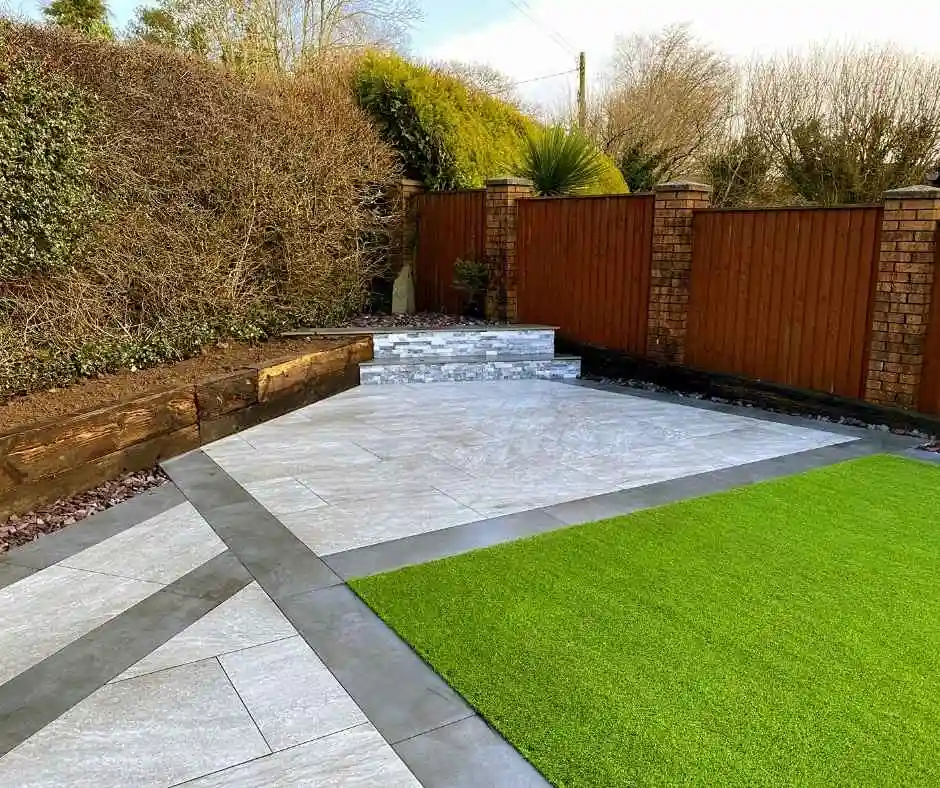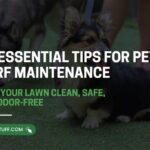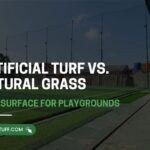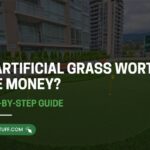Artificial grass is a popular choice for homeowners seeking a low-maintenance, green lawn all year round. Like any landscaping option, it has both advantages and drawbacks.
From saving time on mowing and watering to providing a durable surface for pets and kids, artificial grass offers many benefits. At the same time, factors like upfront cost, heat retention, and proper installation are worth considering.
In this guide, you’ll learn:
- Key benefits of artificial grass
- Potential drawbacks to consider
- How to choose the best turf for your needs
With the right knowledge, you can decide if synthetic turf is the perfect fit for your home and outdoor space.
Table of Contents
Quick Summary
Pros | Cons |
No mowing, fertilizing, or watering required. | Installation can be more expensive than natural grass. |
Can withstand pets, kids, and heavy foot traffic. | Turf can get hot in direct sunlight, especially in summer. |
Always looks lush, regardless of weather. | Doesn’t support insects or wildlife like natural grass. |
No brown spots, puddles, or messy mud. | Poor installation can lead to drainage or leveling issues. |
Easy to clean urine and waste; resists digging. | Made from synthetic materials, not biodegradable. |
Reduces exposure to pollen and insects. | Some people prefer the natural feel of real grass. |
Benefits of Artificial Grass
Artificial grass offers plenty of advantages for homeowners looking for a beautiful, low-maintenance lawn. Here’s why synthetic turf has become a top choice:
1. Low Maintenance
Artificial grass eliminates the need for mowing, fertilizing, or watering, making lawn care simple and effortless. Homeowners can enjoy a consistently neat and green yard without spending hours each week on upkeep.
Key benefits of low-maintenance artificial turf include:
- No mowing or trimming required.
- No fertilizing or chemical treatments.
- No need for regular watering or irrigation.
- Minimal cleanup after pets or children play.
This also translates into long-term savings. You won’t need costly fertilizers, irrigation systems, or lawn equipment, yet your yard remains beautiful year-round.
2. Durable & Long-Lasting
Synthetic turf can handle heavy foot traffic, kids, and pets without wearing down. Unlike natural grass, it stays intact, vibrant, and functional even in high-use areas.
Key durability features include:
- Resistant to digging and scratching.
- Withstands running, jumping, and rough play.
- Maintains color and texture over time.
- Holds up well in all weather conditions.
Its durability makes it perfect for active households. Resistant to digging and rough play, artificial grass provides a safe and long-lasting surface for pets and children.
3. Year-Round Green
Artificial grass maintains a lush, vibrant appearance in every season. It doesn’t brown, patch, or turn muddy, creating a consistently attractive lawn.
Reasons synthetic turf stays green all year include:
- Doesn’t rely on seasonal growth or rainfall.
- Resistant to drought and extreme weather.
- Stays vibrant in sun or shade.
- No bare or patchy areas.
This ensures your yard always looks inviting and polished, whether for entertaining guests or enjoying family activities outdoors.
4. Clean & Mud-Free
Synthetic lawns prevent puddles and muddy areas, keeping your yard clean and easy to navigate. This reduces mess tracked indoors and provides a safer play area for kids and pets.
Key features that keep artificial grass clean include:
- Excellent drainage prevents standing water.
- No mud or soggy patches after rain.
- Easy to rinse or sweep away debris.
- Reduces dirt tracked into the home.
A mud-free yard also means fewer maintenance hassles compared with natural grass, allowing for a tidy and practical outdoor space.
5. Pet-Friendly
Artificial turf is ideal for dogs and other pets. It’s easy to clean, resists digging, and holds up well to regular pet activity without damage.
Reasons artificial grass works well for pets include:
- Quick and simple to rinse after accidents.
- Resistant to digging and scratching.
- Provides a soft, comfortable surface for paws.
- Supports proper drainage to manage waste and odors.
It also offers a comfortable surface for animals and, with proper drainage, can manage waste and odors efficiently, creating a healthy environment for pets and people alike.
6. Allergen & Pest Resistant
Artificial grass doesn’t harbor pollen or attract pests like fleas and ticks. This helps reduce allergy triggers and keeps outdoor spaces safe.
Key features that make synthetic turf allergy- and pest-friendly include:
- No pollen or grass-related allergens.
- Reduces habitats for fleas, ticks, and other insects.
- Keeps outdoor spaces cleaner and healthier.
- Minimizes exposure to seasonal allergens.
Its pest-resistant qualities allow homeowners to enjoy their yard without worrying about insects or seasonal allergens, making it a healthier choice for families.

Drawbacks of Artificial Grass
While artificial grass offers many benefits, it’s important to consider potential drawbacks before making a decision. Being aware of these factors ensures you choose the best solution for your home and lifestyle.
1. Upfront Cost
The installation of artificial grass can cost more than a natural lawn. High-quality turf and professional installation require an initial investment that may feel steep at first.
Key considerations include:
- Price of turf materials.
- Labor and installation costs.
- Site preparation and base work.
- Extras such as infill or edging.
Over time, many homeowners recover this expense through lower water bills and the elimination of routine lawn care.
2. Heat Retention
Synthetic turf can absorb heat and feel hot under direct sunlight, especially during summer. This may make the surface uncomfortable for pets or bare feet.
Points to keep in mind:
- Turf warms more quickly than natural grass.
- Hot surfaces limit barefoot use.
- Shade or light watering helps reduce heat.
Planning shaded areas or adding cooling measures can keep your lawn pleasant even in warmer months.
3. Limited Natural Benefits
Artificial turf does not contribute to soil health, insects, or biodiversity like real grass. This means your yard will be less active as part of the natural ecosystem.
Key differences include:
- No habitat for beneficial insects.
- Reduced soil activity.
- Fewer contributions to local plant and wildlife health.
A synthetic lawn offers a clean, uniform appearance, but it cannot replace the natural role of living grass.
4. Proper Installation Required
Poor installation often leads to drainage issues, uneven surfaces, or premature wear. Professional work is critical for a turf lawn that looks good and performs well.
Important factors include:
- Solid base preparation and grading.
- Correct infill distribution.
- Secure edges to prevent shifting.
- Drainage systems that handle heavy rain.
A well-installed lawn lasts longer and avoids many of the common issues seen in poorly laid turf.
5. Environmental Considerations
Artificial grass is made from synthetic materials that do not break down naturally. Even though it saves water, it still carries an environmental footprint.
Environmental points to consider:
- Turf contains plastics and chemicals.
- Replacement and disposal are required eventually.
- Some products are recyclable or more eco-friendly.
Choosing recyclable turf and maintaining it properly helps reduce the long-term impact.
6. Surface Feel
The texture of artificial grass can feel different from real grass. Some people notice it is firmer or less cushioned underfoot.
Things to note:
- Less softness compared to natural lawns.
- Barefoot walking can feel unusual.
- Relaxing or lying down may feel different.
For many homeowners, this takes some getting used to, though the consistent appearance and low maintenance often outweigh the difference in texture.

How to Choose the Best Turf for Your Needs
Selecting the right artificial grass is essential to make sure it fits your lifestyle, yard requirements, and budget. Not all turf is the same, so paying attention to the right features will help you make a smart choice.
Consider Your Usage
Think about how you plan to use your lawn. If it’s mainly for curb appeal, you can choose turf that focuses on aesthetics. For households with kids, pets, or frequent gatherings, durability should be a top priority.
High-traffic areas require turf with dense, sturdy fibers that can resist wear and tear. Matching turf strength to your lifestyle ensures your lawn looks great and performs well for years to come.
Fiber Type & Length
Artificial grass comes in different fiber lengths and textures, each with its own benefits. Short fibers are easier to clean and maintain, making them practical for busy households or pet owners. Longer fibers provide a softer, more natural look and feel.
Choosing the right balance between aesthetics and functionality helps create a lawn that not only looks inviting but also meets the daily needs of your family and pets.
Drainage & Base Quality
Good drainage is essential, especially if you have pets or live in a rainy climate. Turf with a permeable backing allows liquids to flow through easily, preventing puddles, odors, and mess.
Equally important is the base preparation. A properly layered base supports drainage, creates a smooth surface, and keeps your turf from shifting or becoming uneven over time.
Material Safety & Quality
Artificial turf should be safe for both people and pets. Look for turf made from non-toxic, lead-free materials that don’t contain harmful chemicals. High-quality products also last longer and hold their appearance better.
Safe materials give peace of mind, especially for families with children and pets who spend time playing on the lawn.
UV & Weather Resistance
Sun exposure and weather changes can affect the look and lifespan of artificial turf. UV-stabilized turf resists fading, keeping its vibrant green color even under strong sunlight.
Weather-resistant options also handle heat, rain, and temperature shifts without losing shape, ensuring your lawn stays attractive in every season.
Maintenance Requirements
Some turf products are designed with added features to simplify care. Options with antimicrobial coatings or specialized infill make cleaning easier and help control odors.
Considering how much maintenance you are willing to do helps you select turf that fits your routine. The right choice will save time and keep your lawn fresh and inviting.
Final Thoughts: Is Artificial Grass Right for You?
Artificial grass is a smart choice for homeowners who want a green, low-maintenance yard all year. Though the upfront cost is higher, the long-term savings and convenience often outweigh the drawbacks.
A clean, durable, and pet-friendly lawn can make your outdoor space more enjoyable for the entire family.
The key is choosing the right turf and ensuring proper installation. Quality materials and regular care will keep your lawn vibrant and functional for years.
For expert installation in the Dallas–Fort Worth area, contact Texas Tuff Artificial Grass at (214) 209-9388. Our team specializes in dog-friendly, family-safe turf that looks great and lasts.
FAQs
Yes, high-quality artificial turf is pet-friendly. It’s soft under paws, resists digging, and drains urine effectively. Regular rinsing and occasional cleaning keep the lawn hygienic.
Synthetic turf can retain heat under direct sunlight, especially in summer. Adding shade, watering the surface, or choosing turf designed to reflect heat can make it more comfortable.
With proper installation and regular care, artificial grass can last 10–20 years. UV-resistant materials and good drainage help maintain appearance and durability.
Yes. It requires minimal upkeep compared to natural lawns. Occasional rinsing, removing debris, and using enzyme cleaners for pet areas keeps it looking fresh and clean.
Artificial grass is made from synthetic materials and is not biodegradable. It does save water and reduce chemical use. Choosing recyclable turf and proper maintenance can reduce its environmental impact.







